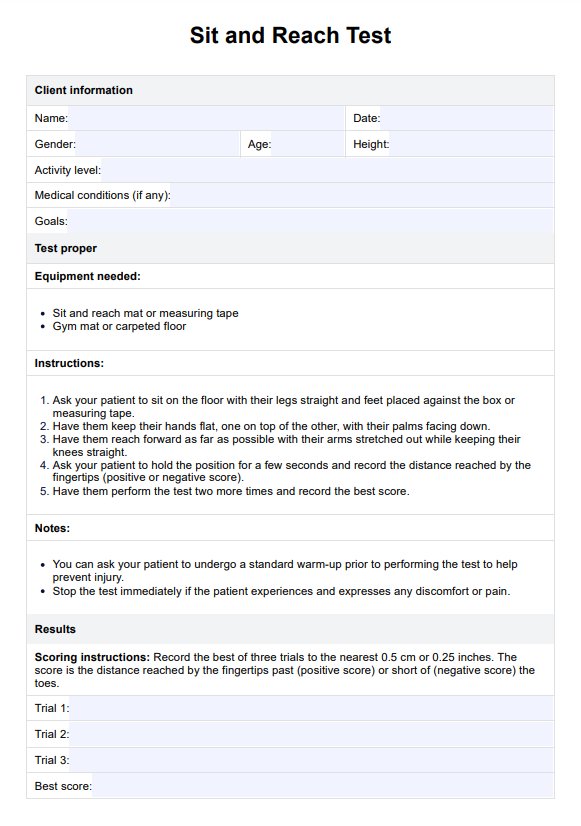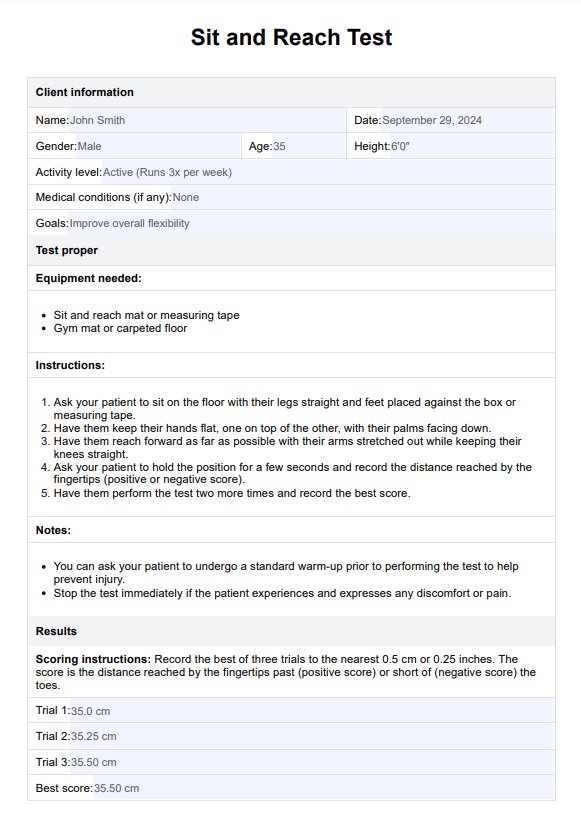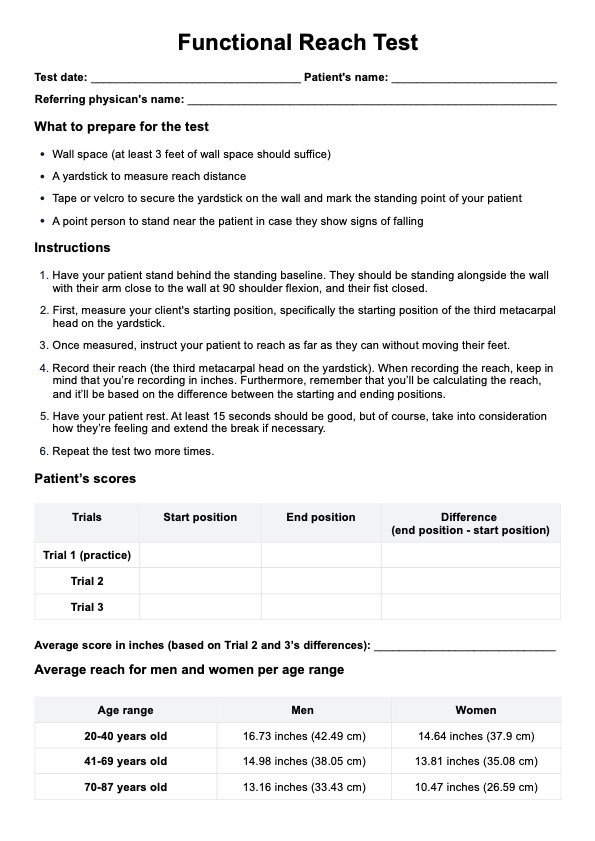Sit And Reach Test
Assess a patient's lower back and hamstring flexibility using the Sit and Reach Test.


What is the Sit and Reach Test?
The Sit and Reach Test is a standard fitness assessment or flexibility test used by fitness professionals, physical therapists, sports medicine coaches and specialists, medical professionals, biomechanics or sports science researchers, and physical education teachers to test hamstring extensibility and measure the flexibility of their patient's lower back and hamstring muscles. To be more specific, the specialists above use the test for fitness testing as a field test, athletic performance evaluation, and physical therapy. Furthermore, the criterion-related validity of the sit and reach test has been demonstrated through various studies, showing its effectiveness and reliability in assessing flexibility across different populations and conditions (Mayorga-Vega et al., 2014).
The Sit and Reach Test can be performed in various ways, including with or without shoes, with or without warm-up, and with or without assistance from a partner or coach. The traditional Sit and Reach Test can also be modified to accommodate individuals with physical limitations or disabilities, thus allowing for a few variations of Sit and Reach Tests.
This test is helpful because flexibility is essential to physical fitness and can impact overall performance and injury risk. The Sit and Reach Test is also relatively easy to administer and requires minimal equipment, making it a popular choice for fitness assessments for men and women.
Sit And Reach Test Template
Sit And Reach Test Example
How to perform the Sit and Reach Test?
The Sit and Reach Test is a quick and easy way to assess a person's lower back and hamstring flexibility. If you follow the test protocol, the test is simple to administer and requires very little equipment.
In this guide, we'll show you the procedure for performing and interpreting the results step by step. By the end of this guide, you'll be able to accurately assess the flexibility of your participants and provide feedback on how to improve it.
Step 1: Set up the equipment
If using a sit-and-reach box, adjust it to the appropriate height for the participant's legs. Place a measuring tape on the floor with the zero mark aligned with the participant's feet if you're using a measuring tape. If using a gym mat or carpet, ensure it's clean and debris-free.
Step 2: Explain the test to the participant
Describe the test and its purpose to the patient, then demonstrate how to perform the test correctly. Emphasize the importance of the participant keeping their legs straight and reaching as far as possible without bouncing or jerking.
Step 3: Warm-up (optional)
Encourage your patient to perform the standardized warm-up with light stretches to warm up their muscles. Perform some dynamic stretching exercises to activate the hamstrings and lower back muscles.
Step 4: Perform the test
Have the participant sit on the floor with their legs stretched and their feet placed against the sit-and-reach box or measuring tape. slowly reach forward. Instruct them to keep their hands flat, one hand on top of the other, with their palms facing down. Ask them to reach forward as far as possible with their arms stretched out in front while keeping their knees straight. Hold the position for two seconds and record the distance reached by the fingertips (positive or negative score) using a measuring tape. After performing the test two more times, record the best score. Note any discomfort or pain experienced by the participant during the test. Document any other observations or comments you may have.
Step 5: Interpret the results
Compare the test scores obtained to norms for the participant's age and gender. The Sit and Reach PDF provided in this guide provides an interpretation guide you can use. Provide feedback on their performance and discuss strategies for improving their flexibility.
Remember always to prioritize the safety of the participant during the test. Stop the test immediately if they experience any discomfort or pain.
Why is this assessment popular with physical therapists?
The Sit and Reach Test is a popular assessment tool physical therapists use for various reasons. Here are three main reasons why physical therapists use this assessment:
Evaluating lower back and hamstring flexibility
The test measures the flexibility of the lower back and hamstrings. Physical therapists can use it to identify tightness or limitations in these areas, which can help inform their treatment plans.
Monitoring progress
Physical therapists often use the Sit and Reach Test to monitor their patients' rehabilitation progress. Retesting the patient periodically allows them to see if their flexibility has improved and adjust their treatment plan accordingly.
Standardization
The Sit and Reach Test is a standardized assessment tool widely used in research studies and clinical practice. This allows physical therapists to compare their patients' results to normative data and track their progress over time.
Benefits of free Sit and Reach Test
The Sit and Reach Test is a popular test for many reasons. Here's a peek at why:
- Easy and quick to administer: The Sit and Reach Test is a simple assessment tool, making it a popular choice for many professionals. It only requires a sit-and-reach box or measuring tape and can be completed in just a few minutes.
- Reliable results: The Sit and Reach Test is reliable for assessing lower back and hamstring flexibility. It is a standardized test used in research studies and clinical practice, meaning the results are consistent and can be compared to normative data.
- Useful for monitoring progress: The procedure is valuable for monitoring progress over time. By repeating the test periodically, professionals can track changes in flexibility and adjust treatment plans as needed.
- Provides insight into injury risk: Tightness in the lower back and hamstrings can increase the risk of injury, particularly in athletes. By using the Sit and Reach Test to assess flexibility, professionals can identify any limitations or tightness in these areas and develop strategies to reduce the risk of injury.
- Versatile assessment tool: The Sit and Reach Test can be used by many professionals, including physical therapists, personal trainers, coaches, and healthcare providers. It is a versatile tool that can assess flexibility in various populations, including athletes, older adults, and individuals with disabilities.
References
Mayorga-Vega, D., Merino-Marban, R., & Viciana, J. (2014, January 1). Criterion-related validity of Sit-and-Reach Tests for estimating hamstring and lumbar extensibility: A meta-analysis. Journal of Sports Science and Medicine, 13(1), 1-14 (PMC). https://www.ncbi.nlm.nih.gov/pmc/articles/PMC3918544/
Commonly asked questions
The Sit and Reach Test is straightforward to use. Simply print out the test and follow the instructions provided. Make sure to record the client's best score and compare it to norms for their age and gender.
Yes! The Sit and Reach Test is often provided in a downloadable format, such as a PDF or Word document, allowing you to customize it to fit your needs. You can add your logo or adjust the layout to suit your practice or organization better.
The Sit and Reach Test can be used on individuals of all ages, from children to older adults. However, norms for the test vary based on age and gender, so it's essential to use appropriate references when interpreting the results. It's also important to consider any medical conditions or limitations affecting an individual's ability to perform the test.





















-template.jpg)




















































































